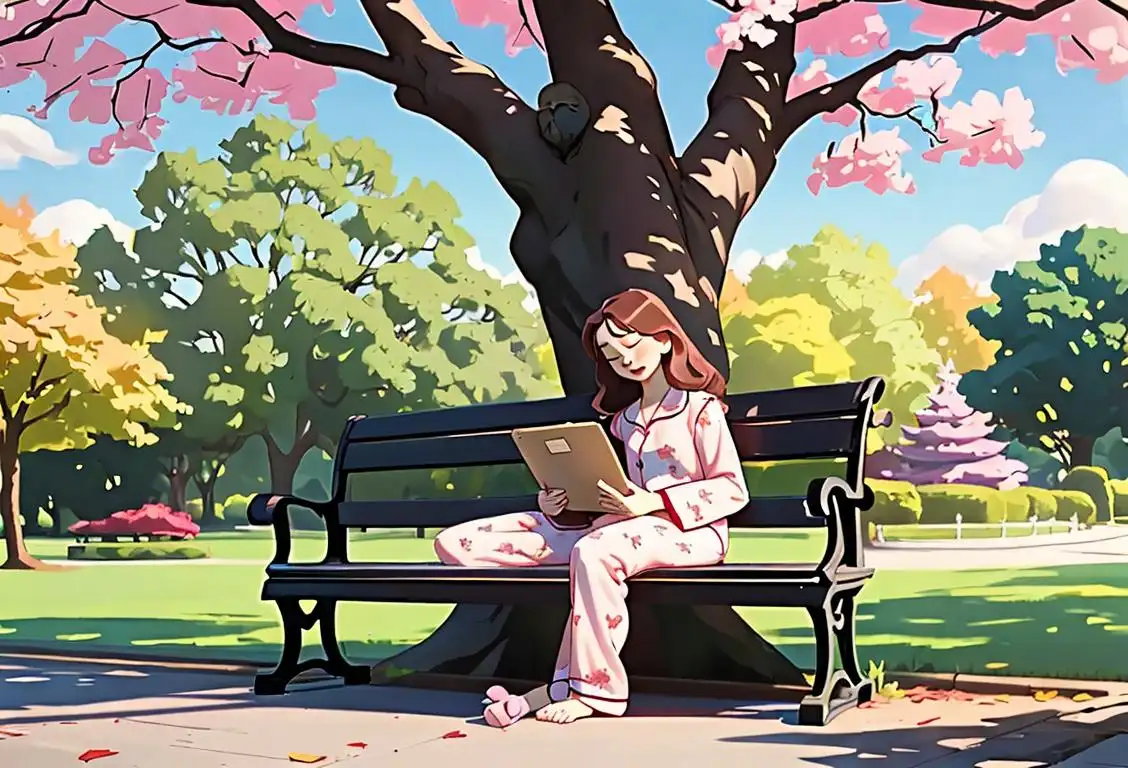National Sleep Till The Next Day

Welcome to the wonderful world of National Sleep till the Next Day! Prepare yourself for a day of rest, relaxation, and some serious snooze time. Whether you're a nap connoisseur or someone who just can't resist hitting the snooze button, this day is dedicated to indulging in those precious ZZZs. So grab your coziest blanket, fluff up your pillows, and let's dive into the fascinating history of this national day!
When is Sleep Till The Next Day?
It's national sleep till the next day on the 22nd January.
Oh, Sleep, How We Adore Thee!
Imagine a world where you could sleep till the next day without any worries or responsibilities. Well, that dream becomes a reality on National Sleep till the Next Day! This delightful day celebrates the importance of getting proper sleep, as well as the joy of having the freedom to snooze to your heart's content.
While the origins of National Sleep till the Next Day are a bit hazy (probably due to lack of sleep), its popularity has soared in recent years. People have been participating in this blissful celebration by curling up in their favorite spot, closing their eyes, and embracing the ultimate form of relaxation.
Why Do We Need Sleep So Much?
Sleep is not just a luxury; it's a necessity. We spend approximately one-third of our lives sleeping, and for a good reason. During this seemingly inactive period, our bodies are hard at work, repairing tissues, boosting our immune system, and consolidating memories.
But it's not just the physical benefits that sleep provides. Just think about how cranky and irritable you get after a poor night's sleep. Getting enough quality shut-eye is essential for maintaining good mental health, enhancing cognitive function, and keeping our emotions in check. In other words, sleep is your secret weapon for being a functioning human being!
Celebrating National Sleep till the Next Day
So, how can you make the most of this glorious holiday? Here are a few ideas:
- Start the day by fluffing up your pillows, so they're extra inviting when you come back to bed.
- Create a cozy ambiance with dim lights, calming scents, and your favorite sleep-inducing sounds.
- Unplug from technology and avoid any screen time at least an hour before bedtime. Let your brain unwind and prepare for deep slumber.
- Indulge in your favorite sleep accessories, be it a silk sleep mask, a soft weighted blanket, or even some fluffy slippers.
- Invest in a good mattress and bedding. Your sleep kingdom deserves the best!
Remember, National Sleep till the Next Day is all about pampering yourself with sleep. Give yourself permission to doze off guilt-free and wake up feeling refreshed and rejuvenated!
History behind the term 'Sleep Till The Next'
1785
Origins of the term
The origin of the term 'sleep till the next' can be traced back to the late 18th century. During this time, people often referred to the following day as 'the next day,' emphasizing its proximity to the present day or the day they were currently in. The term was used to convey the idea of waiting or looking forward to the upcoming day.
1959
The Birth of a Catchphrase
The term 'sleep till the next' first appeared in 1959 as a catchphrase commonly used among friends and acquaintances. It was a lighthearted way to express the desire to sleep through an uninteresting or mundane event and wake up when something more exciting is happening. The phrase quickly gained popularity, especially among youngsters who wanted to make the most of their free time.
1771
Birth of the term 'sleep till the next'
The term 'sleep till the next' originated in the 18th century. It was commonly used to refer to the act of sleeping until the next day or until the next significant event. People would often use this phrase to express a desire to sleep soundly without any disturbances or responsibilities.
1841
The Sleep Revolution Begins
In 1841, a book titled 'The Physiology of Sleep' by Dr. William Macnish was published. This book marked the beginning of the sleep revolution, focusing on the scientific study of sleep and its importance for physical and mental well-being. Dr. Macnish explored various aspects of sleep, including sleep cycles, dreams, and sleep disorders, laying the foundation for future research and understanding of the subject.
1849
Evolution of the expression
As the 19th century progressed, the term 'sleep till the next' began to evolve in both its usage and meaning. It shifted from simply referring to waiting for the following day to encompass the act of sleeping until the next day. This evolution likely stemmed from the association between sleep and the passage of time, as well as the desire for rest and rejuvenation.
1965
Expanding into Pop Culture
By 1965, 'sleep till the next' had made its way into popular culture and was frequently used in movies, TV shows, and songs. This catchy phrase resonated with people who wanted to skip ahead to the next exciting moment without having to endure the boring parts. It became a symbol of anticipation and the desire for instant gratification.
1806
Cultural references in literature
During the 19th century, the term 'sleep till the next' gained popularity in literature. Authors began incorporating it into their works, often depicting characters yearning for a peaceful sleep until the next day. This usage not only expanded the cultural impact of the term but also helped solidify it in the English language.
1879
The Invention of the Light Bulb
The year 1879 saw a major technological breakthrough with the invention of the practical incandescent light bulb by Thomas Edison. With the ability to illuminate the night and extend waking hours, the light bulb significantly impacted people's daily routines and sleeping patterns. The availability of artificial light allowed individuals to have more control over their sleep-wake cycles, leading to changes in sleep duration and the concept of 'sleeping till the next' morning.
1920
Integration into popular culture
In the early 20th century, the term 'sleep till the next' became more prevalent in popular culture. It started to appear in songs, films, and advertisements, further embedding it into the everyday vocabulary of people. This widespread usage contributed to the term's cultural significance and ensured its continued recognition.
1922
Popularization in literature
By the early 20th century, the expression 'sleep till the next' had become a well-known phrase, thanks in part to its appearance in various works of literature. Authors, particularly those in the realm of fiction and storytelling, utilized the term to convey a sense of anticipation or the passage of time. Its inclusion in popular novels and poems further propelled its cultural impact.
1892
Sleeping Past Sunrise
In 1892, the phrase 'sleeping till the next' gained popularity as it became more feasible for people to prolong their sleep beyond the natural sunrise. With the widespread adoption of artificial light, individuals could choose to wake up at a time more convenient for their daily schedules rather than being bound by the rising sun. This newfound flexibility revolutionized the perception of sleep and introduced the idea of waking up after sunrise.
1980
The Digital Age and Memes
With the advent of the internet and the rise of memes in the 2000s, 'sleep till the next' gained a whole new level of viral popularity. Memes featuring the phrase started circulating on social media platforms, often accompanied by humorous images or captions. The term became a way to express impatience or boredom with the present moment, and its widespread usage solidified its place in internet culture.
1950s
Integration into everyday language
During the 1950s, the term 'sleep till the next' became an integral part of everyday language, finding its way into conversations, informal writings, and even advertisements. Its widespread usage showcased the familiarity people had with the expression, solidifying it as a commonly understood phrase. This period marked the gradual transition of the term from a literary device to a colloquial saying.
2010
Integration into Everyday Language
In recent years, 'sleep till the next' has become an integral part of everyday language. It is now used not only to express the desire to fast-forward through uneventful periods but also as a metaphor for looking forward to something exciting in the future. The catchphrase continues to evolve and adapt as new generations imbue it with their own interpretations, ensuring its relevance in contemporary culture.
1935
The Introduction of Daylight Saving Time
Daylight Saving Time (DST) was first introduced in 1935 in the United States. This practice aimed to maximize the use of daylight during the summer months by adjusting the clocks forward by one hour. The implementation of DST further altered sleep patterns and introduced the notion of 'losing an hour of sleep' when transitioning to the DST schedule. This change in timekeeping added another layer of complexity to the concept of 'sleeping till the next' morning.
1960
Modern usage in colloquial language
As society progressed, the term 'sleep till the next' became deeply ingrained in colloquial language, especially in informal conversations. It evolved to signify not only a desire for undisturbed sleep but also a hope for a fresh start or a better tomorrow. This multifaceted usage showcased the term's flexibility and adaptability to different contexts.
1998
The Advent of 24/7 Society
With the rise of the digital age and globalization, the concept of a 24/7 society emerged in the late 20th century. The world became increasingly connected, and various industries began operating around the clock. This evolution further blurred the boundaries of traditional sleep schedules, resulting in people adapting their sleeping routines to accommodate the demands of a constantly active society. 'Sleeping till the next' transformed into a personal choice influenced by individual lifestyles and responsibilities.
2021
Continued relevance in contemporary culture
Today, the term 'sleep till the next' remains firmly embedded in the cultural zeitgeist. It continues to be used across various mediums, including social media, where it has become a hashtag and a way to express anticipation for the next day or event. Its enduring popularity illustrates the universal desire for restful sleep and the importance of looking forward to future opportunities.
Present
Continued usage and cultural significance
Today, the phrase 'sleep till the next' continues to be used in various contexts and remains a cultural touchstone. It is employed to express excitement for the future, the anticipation of a new day, or the desire for a well-deserved rest. The endurance of this term throughout the years is a testament to its versatility and its ability to resonate with individuals across different generations.
Did you know?
Did you know that cats are expert sleepers, spending around 70% of their lives snoozing? Now you have a solid excuse to take a cue from our feline friends and indulge in some extra sleep on National Sleep till the Next Day!Tagged
fun relaxationFirst identified
22nd January 2021Most mentioned on
22nd January 2021Total mentions
53Other days
Public Sleeping Day
Slow Down Day
Eat Outside Day
Nothing Day
Drop Everything And Read Day
No Housework Day
No Children Day
Goof Off Day
Bubble Bath Day
Bathtub Party Day








